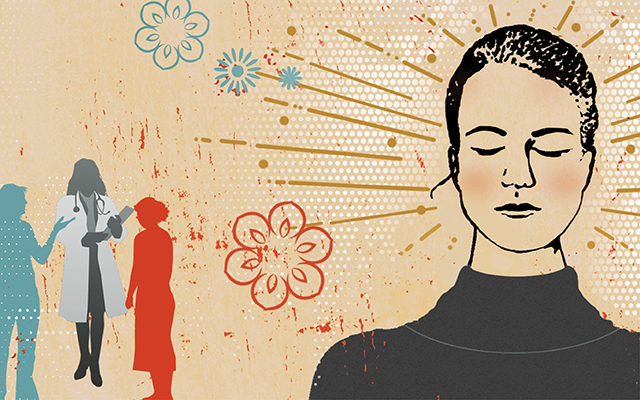Editors’ note: For more than 15 years, celebrated author and pioneering medical visionary Mark Hyman, MD, has been practicing and promoting a revolutionary healthcare concept known as functional medicine. It’s a patient-centered (vs. disease-centered) approach that focuses on identifying and addressing the root causes of chronic health challenges as opposed to merely treating symptoms. Functional medicine also emphasizes incorporating nutrition and lifestyle solutions rather than relying exclusively on pharmaceutical and surgical interventions. Experience Life is proud to bring you this six-part series in which Dr. Hyman describes the emerging practice of functional medicine and explains how it can improve your well-being.
It’s October, the presidential election is upon us, and we’ve all experienced a campaign season filled with politicians of all stripes debating access to healthcare. The problem? With all the debate over healthcare access, the real issue — the quality and effectiveness of that healthcare — has gone unaddressed.
I felt the same frustration when I watched Michael Moore’s documentary Sicko. Don’t get me wrong. I applaud Moore for provoking more debate on healthcare, and I’m all for more access to healthcare and lower costs. But I don’t support giving more people access to a broken healthcare system that creates more problems than it solves.
Consider this: Our “sick” healthcare system itself is responsible for more than 700,000 deaths each year from medical errors, hospital infections, bed sores, surgical errors and drug reactions — that’s more than the number of victims claimed by heart disease or cancer. Plus, flaws in the system cost several billions of dollars annually. As a doctor, this is not the type of care to which I’d like to see more people exposed.
Our “sick” healthcare system itself is responsible for more than 700,000 deaths each year from medical errors, hospital infections, bed sores, surgical errors and drug reactions — that’s more than the number of victims claimed by heart disease or cancer.
Moore’s answer to all our healthcare woes is to have a single-payer system, like Canada’s. Universal coverage may be part of the solution (or not), but if we improve a broken system just by reorganizing how it is funded, we still have a broken system.
The type of symptom-based, disease-oriented medicine we are practicing is antiquated, often dangerous, and it’s based on the wrong premises and outdated approaches. Instead, it must be founded on the laws of biology that help us address the true causes of disease, not just find better drugs or procedures to deal with them once they occur. Giving more people access to the wrong treatments does not help us in the long term to create a sustainable model of health for society.
What’s missing in the healthcare debate is a direct discussion and analysis of the lack of quality in our healthcare system. And quality is defined as the health of our population, which is clearly worse than almost every developed nation and worse than many third-world countries: Americans rank 45th in life expectancy, worse than Bosnia and just ahead of Albania! And yet our nation’s total annual healthcare bill is 40 percent higher than that of any other country, some $2.3 trillion a year (one-third of which goes to administration costs). That’s more than $7,500 per person. And what do we get for all that money? A system that mostly ignores the patient’s health.
Making It Better
The American healthcare system has been a subject of great interest to me as I have moved through various roles in my life — from family physician and emergency-room doctor, to chronically ill patient, to systems and functional medicine practitioner, to researcher, to clinic owner, to consumer educator.
There is no question in my mind that the inherent problems in our healthcare system — which profits from reducing access to care, denying care, avoiding preventive care or shifting costs to employers — are in desperate need of transformation. When a company like Starbucks pays more for its employees’ healthcare than it does for coffee beans, then we know we are in trouble.
Indeed, the entire ecosystem of business and products and services related to the health of our population operates on the basis of a flawed model: The healthcare industry and the food industry profit from us being sick and fat — not healthy and vital.
“It is difficult to think of any major industry that might benefit if people ate less food; certainly not the agriculture, food product, grocery, restaurant, diet or drug industries. All flourish when people eat more, and all employ armies of lobbyists to discourage governments from doing anything to inhibit overeating.”
Currently, all the incentives are backward. As Marion Nestle, PhD, MPH, professor of nutrition, food studies and public health at New York University put it in a 2003 editorial in Science magazine, “It is difficult to think of any major industry that might benefit if people ate less food; certainly not the agriculture, food product, grocery, restaurant, diet or drug industries. All flourish when people eat more, and all employ armies of lobbyists to discourage governments from doing anything to inhibit overeating.”
Clearly, something needs to change. Until it is profitable for everyone to help create health rather than disease, we will not thrive as a society. So we need to find a way to line up all the incentives for everyone involved in healthcare, including:
- The insurers
- The government (which actually pays 60 percent of all healthcare bills through Medicaid, Medicare, the Veteran’s Administration, tax deductions and other incentives)
- The pharmaceutical industry
- The hospital industry
- The food industry (which should profit more from selling products that support health than from selling foods that destroy health)
- The doctors (who should be paid more for creating health than for doing procedures)
We have to change the competing needs in the healthcare industry and related industries. Promoting and treating sickness should not generate more profit. Creating health should.
So how can we, as a society, line up all the needs and interests of all stakeholders in our “sick” healthcare system? If we follow the trail through our healthcare forest, it becomes clear that if there is to be meaningful change, an alignment of values, needs and interests must occur. It also becomes clear that no one component can be separated from any other — that, like a forest, the system producing our current state of health must be regarded as an integrated and self-perpetuating network.
Let’s follow the trail of a simple soda and French fries, for example:
- The government pays farmers $30 billion a year in subsidies to grow corn and soy crops, which the fast- and junk-food industries use to make high-fructose corn syrup and trans fatty acids, the primary ingredients in energy-dense, poor-quality, disease-creating foods such as soda and French fries. (For more on our problematic food industry, see “Progressive Eaters, Unite!”)
- Meanwhile, funds for local schools are limited so they cannot provide students with quality food choices and physical education programs.
- Then the food industry steps in, encouraging children to choose nutrient-poor, energy-dense foods from school lunch lines and vending machines.
- Companies spend more than $30 billion a year marketing these products (more than $13 billion of which is aimed at children), increasing demand.
- These are tax-deductible expenses to corporations — in effect, further subsidies by our government.
- These children then become obese and diabetic in their 20s and require care for heart disease and amputations before they are 30. And, if the patient can’t afford that medical care, the government ends up picking up the tab through Medicaid or through tax write-offs for hospitals providing charity care.
So what is the answer? Clearly, it’s a complex one, because the politics of food, agriculture, environment and education cannot be divorced from the traditional healthcare stakeholders: patients, providers, insurers, employers, payers and government. Ultimately, we have to address the roots of the problems and create a system in which everyone involved thrives. That means rethinking the true costs and true profits of this system at every level.
Honest Reckoning
The real underlying problem to be solved is this: How do we shift our scientific approach to illness from reductionism (treating symptoms and diseases) to systems biology (treating causes and creating health)? And how do we change the way we deliver that care?
We have to think beyond just the patient in the exam room and his or her doctor simply dispensing prescriptions for diseases and symptoms. We have to consider all the potential health influences that may have brought that patient to that exam room in the first place.
Just as we ask, “What is the real cost to society of cigarette smoking?” we should be asking: What are the real, long-term costs of a nation of overfed and undernourished citizens — citizens broadly encouraged to consume goods and services that have been clearly shown to create disease and increase all kinds of public costs?
We should also be asking: How can we change the fact that it is relatively hard to find health-promoting foods, activities, products and services in this country? What is the true cost in lost dollars, productivity, health and well-being from a large serving of trans-fat-soaked French fries or a 48-ounce soda consumed three times a week for a decade or more? What is the cost of cities and communities designed around cars rather than human beings? What is the impact on our bodies of decreased fitness and progressive muscle loss that results from our car- and computer-addicted population and that is linked to every known degenerative disease?
That’s a lot of questions, and there is no one simple answer — no magic pill to cure our diseased healthcare ecosystem. But there are some clear opportunities we must grasp — opportunities to change our thinking, our public policies and our daily habits in directions we’ll all find more rewarding in the long run.
So what are we to do? For starters…
- We have to adopt new ways of looking at chronic disease, and new ways of thinking about how all the problems and symptoms a patient has might be connected.
- We need to think of helping people within a whole ecosystem of healthcare, not just the one-on-one, eight-minute office visit.
- We need to use healthcare teams and group education on lifestyle, nutrition, exercise and stress reduction to help people deal with the causes of their problems.
- We need to change research by allocating funding for what might work best, not what might make a company the most money. We currently embrace the latest drug or procedure without really looking at how it compares with the old drugs or an integrated lifestyle solution.
- We need to rethink the use of placebos (fake pills) as the comparison group for new treatments. Instead, we should see how treatments compare with complete lifestyle and systems approaches, including diet, exercise, stress reduction and cognitive therapies. When drugs have been compared with these approaches, the drugs usually do worse!
The main question we face today is this: How can we find a way to reinvent healthcare practices to accommodate the changes in science, the advance of information technology, and the shift toward patient-directed and patient-centered healthcare?
These are the real questions and issues we need to be making the basis of our healthcare debate. Because in a desperately outdated, flawed, expensive and misaligned healthcare system, these are the concerns essential to our collective survival and renewal.
It’s time for us to move from ordinary to extraordinary thinking about both health and healthcare. A better healthcare reality is eminently possible, but if we want to stem the impending tsunami of ill health and economic burden facing us, we all have to work together, and we have to demand — and create — something different.
Real healthcare reform requires a fundamental change in our worldview about health — a view that helps us understand the core causes of illness, that empowers us to transform and safeguard our own health, and that transforms our “sick care” system to a true healthcare system. But it all starts with our willingness to make small changes in the way we live, and in the way we think about our health. We all need to look carefully at how our current thinking leads us either toward or away from our common unspoken goal: to create a sustainable healthcare system and society so that our children and their children can thrive.
The Money Game
My favorite part of Michael Moore’s documentary Sicko was when a British doctor described how he was paid more to help people lose weight, stop smoking, improve their blood sugar and lower their cholesterol. If an American doctor does that, he or she loses money. The American doctor earns thousands of dollars for doing angioplasties and stent procedures and maybe $30 for talking to someone about his or her cholesterol; British doctors actually get a bonus for keeping people healthy!
The American doctor earns thousands of dollars for doing angioplasties and stent procedures and maybe $30 for talking to someone about his or her cholesterol.
Of all the problems with our healthcare system, one of the most glaring is the fact that the payment system is based on procedures and on diagnoses. Indeed, if you created a model of healthcare that addressed the underlying causes of illness and focused on prevention, a lot of the healthcare structure would collapse.
Take the New York City hospital that had to shut down its diabetes prevention program because it was so successful helping patients improve their health, it actually reduced amputations and other serious complications of diabetes. But the hospital was losing money because it was being reimbursed from insurance only for nutrition consults ($60) instead of toe amputations ($6,000).
Though doctors are generally well-meaning people, the healthcare system encourages them to do more procedures and provide more invasive care by paying them more for those procedures — even if it ultimately does not benefit the patient. That’s because the healthcare system almost never addresses the real value of the care patients are receiving. If I can spend an hour and a half with a patient and show him how to change his diet and lifestyle in such a way that he can begin living a healthier life, I might get paid only $500, but the actual value of the treatment could be much higher if it leads to a life free of disease, disability and loss of productivity.
The 7 Keys to UltraWellness
Simply put, when your core systems are out of balance, they make fertile ground for the roots of illness. When they are in balance, they become the keys to creating wellness and vitality:
- Environmental Inputs (diet, lifestyle, toxins, stress and trauma)
- Inflammation and Immune Balance (the hidden fire within)
- Hormone and Neurotransmitter Balance (insulin, thyroid, adrenal balance; sex hormones and mood chemicals)
- Gut and Digestive Health (digestion, absorption, assimilation, intestinal ecosystem and the gut-immune system)
- Detoxification Imbalances and Function (getting rid of wastes and dealing with toxins)
- Creating Energy (the source of life energy and metabolism — antioxidant balance)
- Mind-Body/Body-Mind Connection (change your mind, change your body; change your body, change your mind)
Learn more about the fundamentals of functional wellness by reading the other articles in this six-part series:




This Post Has 0 Comments